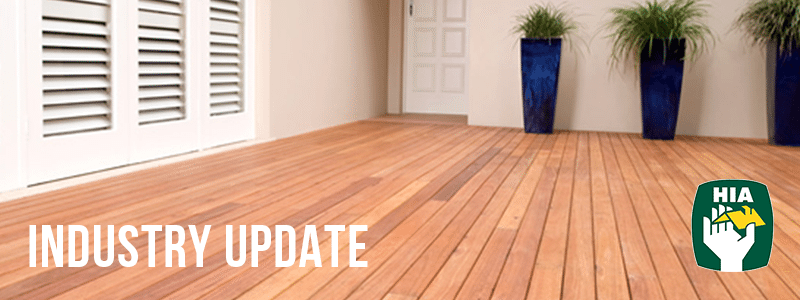An Australian home just isn’t complete without an outdoor deck area. But good design, installation and maintenance of timber decks is vital to ensure that this part of the home will look fantastic for many years after construction.
This article sets out to address several design, installation and maintenance issues that, if ignored, can lead to serious problems; principally premature deterioration of the timber deck boards. HIA is often in the unfortunate position of assisting member’s manage problems associated with buildings works that haven’t performed as well as could be expected over a period of time.
Hardwood timber decking board installation is one such area where small mistakes can lead to expensive consequential rectification works. This article highlights measures that, if adhered to, will help extend the life of hardwood timber decking boards and the subfloor structure.
Design
Hardwood timber decking boards will maintain their appearance and form for a longer period of time if they’re covered by a roof. Whilst this isn’t always possible, a timber deck that is covered can deliver enormous benefits to the home owner, namely:
- The decking boards will not have to be re-oiled as often if the deck is protected from the full exposure of the weather
- As the boards won’t be exposed to the full weather extremes they won’t expand/contract as much, thereby reducing the likelihood of timber splitting, warping, cupping etc.
- The deck will require less cleaning - less leaves and dust will collect on the deck if the area is covered
If the decking area cannot be covered it is worth considering using narrower decking boards as they shed water more readily and will therefore be less prone to warping.
Installation
Joist protection consists of rubber or other material placed on top of the joist but under the decking board. This will help protect the joist from water ponding in the decking board gaps which can lead to joists deteriorating prematurely. This is a fairly cheap product and will go a long way to protecting the joists and extending the life of the member. This is not a mandatory requirement but is now almost standard practice in the industry.
Boards may be laid reeded side up* or down; however installing board’s reeded side up for the reason that the grooves in the board will act as a non-slip surface is erroneous. The grooves in the boards will without vigilant cleaning, invariably act as a dirt and grime collection area which will in turn make the boards a slip hazard and lead to premature deterioration. It would be prudent to always lay hardwood timber decking with the reeded side down.
*Suppliers dont often recommend this way as it speeds up the deterioration process of the timberDecking board spacing is an important consideration, however there is no regulatory standard stipulating a definite figure. Timber industry groups generally will suggest a gap of 3mm for 90mm boards and up to 5mm for wider boards, once again this is a suggested and nominal dimension. Good building practice indicates that wider boards than 90mm should be thicker than 19mm. e.g. 140mm board should be a minimum of 22mm.
Installers will need to consider the timber species, the moisture content of the timber, climatic conditions and local experience when determining the distance between timber decking boards. Installing boards with larger gaps than suggested could create a trip hazard and installers should be wary of deviating from industry recommendations.
All surfaces of decking boards are required to be sealed with a water repellent preservative or oil based primer plus one coat of the selected finish (this includes cut ends) prior to laying.
Predrilling of decking boards at butt joints is recommended with a suggested drill bit size approximately 80% of the diameter of the nails suggested.
The nails should be finished flush with decking board surface and not punched as this can lead to premature deterioration of the decking boards. Installers should be particularly wary of this point when fixing decking boards with a nail gun.
Maintenance
Installers must make owners aware that they need to maintain their timber deck with regular cleaning such as sweeping and removal of garden debris. The use of a hose or a pressure cleaner should be discouraged.
Home owners must further be advised of the need to frequently reapply coatings to decking boards to prevent premature deterioration of the decking boards. The regularity of these recoating’s must be judged according to individual siting conditions where differences in the amount of exposure to the weather will greatly determine the regularity of maintenance required for a particular timber deck.
Summary
An outdoor hardwood timber deck can be a great entertaining area and serve the home owners for many years provided good design, installation and maintenance is performed on the decking area.
For more information HIA members can contact HIA Building Services on 1300 650 620 or email hia_technical@hia.com.au.
Craig Jennion
HIA Executive Director – Hunter



